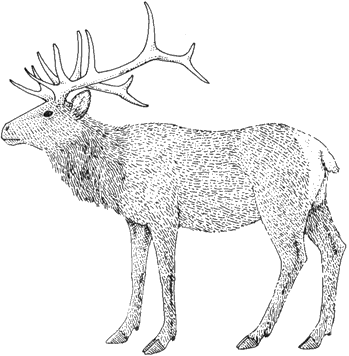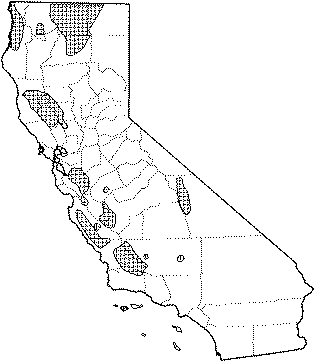
Elk
Distribution, Abundance, and Seasonality
Uncommon to common. Permanent resident with a scattered, reduced distribution now in California. Three subspecies occur in the state: Rocky Mountain elk (C. e. nelsoni, introduced); tule elk (C. e. nannodes, native); and Roosevelt elk (C. e. roosevelti, native). Rocky Mountain and Roosevelt elk breed in open, brushy stands of many deciduous and conifer habitats with abundant water. They feed in riparian areas, meadows, and herbaceous and brush stages of forest habitats. Several introductions, and reintroductions, of tule elk have been made by the California Department of Fish and Game in recent years. Tule elk introduced into the Owens Valley, Inyo Co., use brush, scrub, and herbaceous habitats throughout the year (McCullough 1969).

Range Map
Specific Habitat Requirements
Feeding: Herbivorous; they graze and browse. Diet varies greatly geographically. Eat grasses, forbs, tender twigs and leaves of shrubs and trees, fungi, some mast, and aquatic vegetation. In the Owens Valley, tule elk consumed substantial amounts of alfalfa in summer (McCullough 1969). At Prairie Creek, Humboldt Co., grasses made up 56-76%, and browse 21-34%, of the forage consumed (Harper et al. 1967). Forage on ground and into shrubs, and up to 1.8 m (6 ft) in trees.
Cover: Roosevelt and Rocky Mountain elk require mature stands of deciduous and conifer forest habitats. Dense brush understory is used for escape and thermal cover. These habitats are particularly important on south-facing slopes for cover in winter. In the Owens Valley, tule elk inhabit bottomlands with herbaceous vegetation, and low slopes and alluvial fans supporting predominately brushy habitats (McCullough 1969).
Reproduction: Calving occurs in areas with available water and brushy vegetation, that provide dense cover near openings, and seclusion from human impacts.
Water: The distance between open water sources should be no greater than 3.2 km (2 mi).
Pattern: Roosevelt and Rocky Mountain elk use uneven-aged forest stands that include old-growth, herbaceous openings, and water. These elk do not travel far from the cover of forest. Tule elk in the Owens Valley inhabit brush, scrub, and herbaceous habitats McCullough 1969).
Species Life History
Activity Patterns: Active yearlong. Mostly crepuscular and nocturnal, some diurnal activity.
Seasonal Movements / Migration: Herds are sedentary within an annual home range, or migrate altitudinally. McCullough (1969) found the primary factor causing movement of tule elk herds in Owens Valley was availability of sufficient forage of high quality.
Home Range: Home ranges of cow-calf herds Humboldt Co. averaged 2.9 km? (1.1 mi?) (Franklin et al. 1975). In Rocky Mountains, home ranges up to 50 km? (20 mi?) reported (Thomas and Toweill 1982). Elk herds may travel established routes in home ranges.
Territory: During the rut, bulls defend movable breeding territories consisting of cow harems. Territories of cow-calf herds in Humboldt Co. averaged 75 ha (185 ac) (Franklin et al. 1975).
Reproduction: Rut occurs from August into November. Gestation period about 255 days; most young in California born in May and June. Usually 1 calf born, occasionally 2, rarely 3. Young born in secluded areas with good cover. Cows sexually mature at 2 yr. In sedentary herds, female calves usually remain with mothers to form the cow-calf herds to which they belong throughout their lives. Adult males live separately in bull herds, and join cows only during rut.
Niche: Populations require seclusion from human interference, protection from poaching, and management to prevent local overpopulation. Proper management of forest and recreational activities can provide these requirements, and the mixture of habitats essential to health of the 3 subspecies. Humans, mountain lions, and coyotes are the major predators of elk, although a few, mostly young, probably are killed by black bears, bobcats, and feral dogs. Some competition for food and cover may occur between elk and domestic lifestock, wild horses, and deer. Diseases and parasites in elk in California, include anthrax, bluetongue, paratuberculosis, necrobacillosis, and cyclophyllidean tapeworms (Davis and Anderson 1973, Davis et al. 1973). Also called wapiti.
Sources & References
California Department of Fish and Game, 1999.
California's Wildlife, Sacramento, CA.
Written by: G. Ahlborn, reviewed by: M. White, edited by: M. White, G. Ahlborn
Boyce, M. S., and L. D. Hayden-Wing, eds. 1979. North American elk: ecology, behavior, and management. Univ. Wyoming, Laramie. 294pp. Davis, J. W., and R. C. Anderson, eds. 1973. Parasitic diseases of wild mammals. Iowa State Univ. Press, Ames. 364pp. Davis, J. W., L. H. Karstad, and D. O. Trainer, eds. 1973. Infectious diseases of wild mammals. Iowa State Univ. Press, Ames. 421pp. Franklin, W. L., A. S. Mossman, and M. Dole. 1975. Social organization and home range of Roosevelt elk. J. Mammal. 56:102-118. Harper, J. A., J. H. Harn, W. W. Bentley, and C. F. Yocom. 1967. The status and ecology of the Roosevelt elk in California. Wildl. Monogr. No. 16. 49pp. Lieb, J. W. 1973. Social behavior in Roosevelt elk cow groups. M.S. Thesis, Humboldt State Univ., Arcata, CA. 82pp. Mackie, R. J. 1970. Range ecology and relations of mule deer, elk and cattle in the Missouri River Breaks, Montana. Wildl. Monogr. No. 20. 79pp. McCullough, D. R. 1969. The tule elk: It's history, behavior, and ecology. Univ. Calif. Publ. Zool. 88:1-209. Murie, O. J. 1951. The elk of North America. Wildl. Manage Inst., Washington, DC. 376pp. Peek, J. M., and S. R. Hieb, eds. 1976. Elk-logging-roads symposium. Univ. Idaho, For. Wildl., and Range Exp. Sta., Moscow. 142pp. Thomas, J. W., and D. E. Toweill, eds. 1982. Elk of North America. Stackpole Books, Harrisburg, PA. 698pp.
California Animal Facts | California's Wildlife